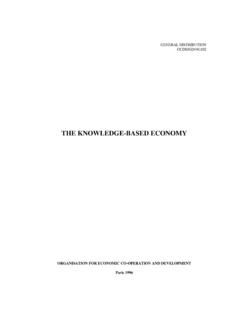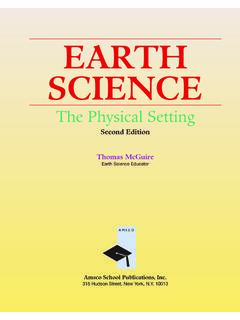Transcription of Agriculture 4.0 Agricultural robotics and automated ...
1 Agriculture StartAgricultural robotics and automatedequipment for sustainable crop productionIntegrated CropManagement Vol. 24 | 2020 ISSN 1020-4555 Food and Agriculture Organization of the United Nations Rome, 2020 BySantiago Santos Valle, Agricultural Mechanization Specialist, FAOJ osef Kienzle, Agricultural Engineer, FAONOVEMBER 2020 Agricultural robotics and automatedequipment for sustainable crop productionIntegrated CropManagement 24 | 2020 Agriculture Required citation:Santos Valle, S. and Kienzle, J. 2020. Agriculture Agricultural robotics and automated equipment for sustainable crop production.
2 Integrated Crop Management Vol. 24. Rome, designations employed and the presentation of material in this information product do not imply the expression of any opinion whatsoever on the part of the Food and Agriculture Organization of the United Nations (FAO) concerning the legal or development status of any country, territory, city or area or of its authorities, or concerning the delimitation of its frontiers or boundaries. The mention of specific companies or products of manufacturers, whether or not these have been patented, does not imply that these have been endorsed or recommended by FAO in preference to others of a similar nature that are not views expressed in this information product are those of the author(s) and do not necessarily reflect the views or policies of FAO.
3 ISSN 1020-4555 FAO, 2020 Some rights reserved. This work is made available under the Creative Commons Attribution-NonCommercial-ShareAlike IGO licence (CC BY-NC-SA IGO; ). Under the terms of this licence, this work may be copied, redistributed and adapted for non-commercial purposes, provided that the work is appropriately cited. In any use of this work, there should be no suggestion that FAO endorses any specific organization, products or services. The use of the FAO logo is not permitted. If the work is adapted, then it must be licensed under the same or equivalent Creative Commons licence. If a translation of this work is created, it must include the following disclaimer along with the required citation: This translation was not created by the Food and Agriculture Organization of the United Nations (FAO).
4 FAO is not responsible for the content or accuracy of this translation. The original [Language] edition shall be the authoritative edition. Disputes arising under the licence that cannot be settled amicably will be resolved by mediation and arbitration as described in Article 8 of the licence except as otherwise provided herein. The applicable mediation rules will be the mediation rules of the World Intellectual Property Organization and any arbitration will be conducted in accordance with the Arbitration Rules of the United Nations Commission on International Trade Law (UNCITRAL).Third-party materials. Users wishing to reuse material from this work that is attributed to a third party, such as tables, figures or images, are responsible for determining whether permission is needed for that reuse and for obtaining permission from the copyright holder.
5 The risk of claims resulting from infringement of any third-party-owned component in the work rests solely with the , rights and licensing. FAO information products are available on the FAO website ( ) and can be purchased through Requests for commercial use should be submitted via: Queries regarding rights and licensing should be submitted to: Art&Design srliiiAgricultural technologies are rapidly evolving towards a new paradigm Agriculture Within this paradigm, digitalization, automation and artificial intelligence play a major role in crop production, including weeding and pest control. This evolution presents both challenges and opportunities, such as leapfrogging from manual and animal-driven technologies to automated and mechanized equipment in developing countries and closing the digital divide.
6 Traditional Agricultural mechanization, characterized by the use of tractors and engine power, will be matched and even surpassed by automated equipment and robotics and the precision they can provide in farm operations. Conservation Agriculture (CA) is an approach that involves crop diversification, permanent soil cover and minimal soil disturbance ( limited tillage). CA increases soil structure and soil organic matter, promotes rich microbial diversity, retains water and nutrients, and better manages pests and diseases, making Agricultural soils more productive and resilient to changes in climate. However, it requires specialized equipment for example, for direct drilling of crop seed into the soil at the right depth and sowing density.
7 Agricultural robotics can support these environmentally sustainable practices, by allowing spot weeding and precision management of nutrients, pests, diseases and weeds through mechanical removal or spot application of chemicals. Agricultural robots will also be able to substitute arduous labour, especially when there is limited availability, thus increasing social sustainability. The development of Agriculture will create new opportunities that can attract youth and entrepreneurs into the sector, tackling some of the causes for rural urban migration and contributing to the economic component of sustainability.
8 This report analyses the application of robotics in the area of Agricultural mechanization for crop production, and its specific applicability in the context of sustainable development. It takes into consideration the social, economic and environmental dimensions of its adoption and explores its potential. It presents some of the technical characteristics of robotics and highlights major challenges to overcome in order to achieve its successful adoption, such as adequate infrastructure, stakeholder capacity, economic viability and data ownership. This report provides an analysis of some of the major areas of intervention that are needed for the different stakeholders, including smallholder farmers in developing CONTENTS vFOREWORD viiACKNOWLEDGEMENTS viiiABBREVIATIONS AND ACRONYMS ix1 BACKGROUND 1 Aim of report 32 Agriculture .
9 DRONES, ROBOTS AND ICTS 5 Agricultural robotics 7 Use of agrobotse 83 DRIVERS OF THE ADOPTION 11 Challenges 124 DEVELOPING COUNTRIES AND Agricultural robotics PERSPECTIVES 15 Agricultural applications 15 Agribusiness options 16 Drudgery reduction for small-scale farmers 17 Contribution to achieve Sustainable Development Goals 175 CONCLUSION 19 REFERENCES 21 ANNEXES - List of typologies and examples of agrobots adaptation optionsg adaptation actions 23 FIGURES1. Average farm size, 1960 20002. Comparison between a smart farm ( Agriculture ) and a small-scale farm (conventional Agriculture )3.
10 Information-based management cycl for advanced agriculture4. Graphic concept of Agriculture at farm operation level5. Concept of an agrobot weeding mechanically with a beam of light6. Solar-powered robot7. Self-powered platform8. Small robot for weeding9. Specialized agrobot for strawberry harvesting10. Signal coverage of 3G technology in France and Zambia11. Hands Free Hectare project: a 1980s harvester and a conventional small four-wheel tractor pulling a trailer12. Sustainable Development Goals to which Agricultural robotics can contributeviAGRICULTURE : Agricultural robotics AND automated EQUIPMENT FOR SUSTAINABLE CROP PRODUCTIONAGRICULTURE : Agricultural robotics AND automated EQUIPMENT FOR SUSTAINABLE CROP PRODUCTION AgerrisviiMechanization is a key driver of efficient farming systems.













